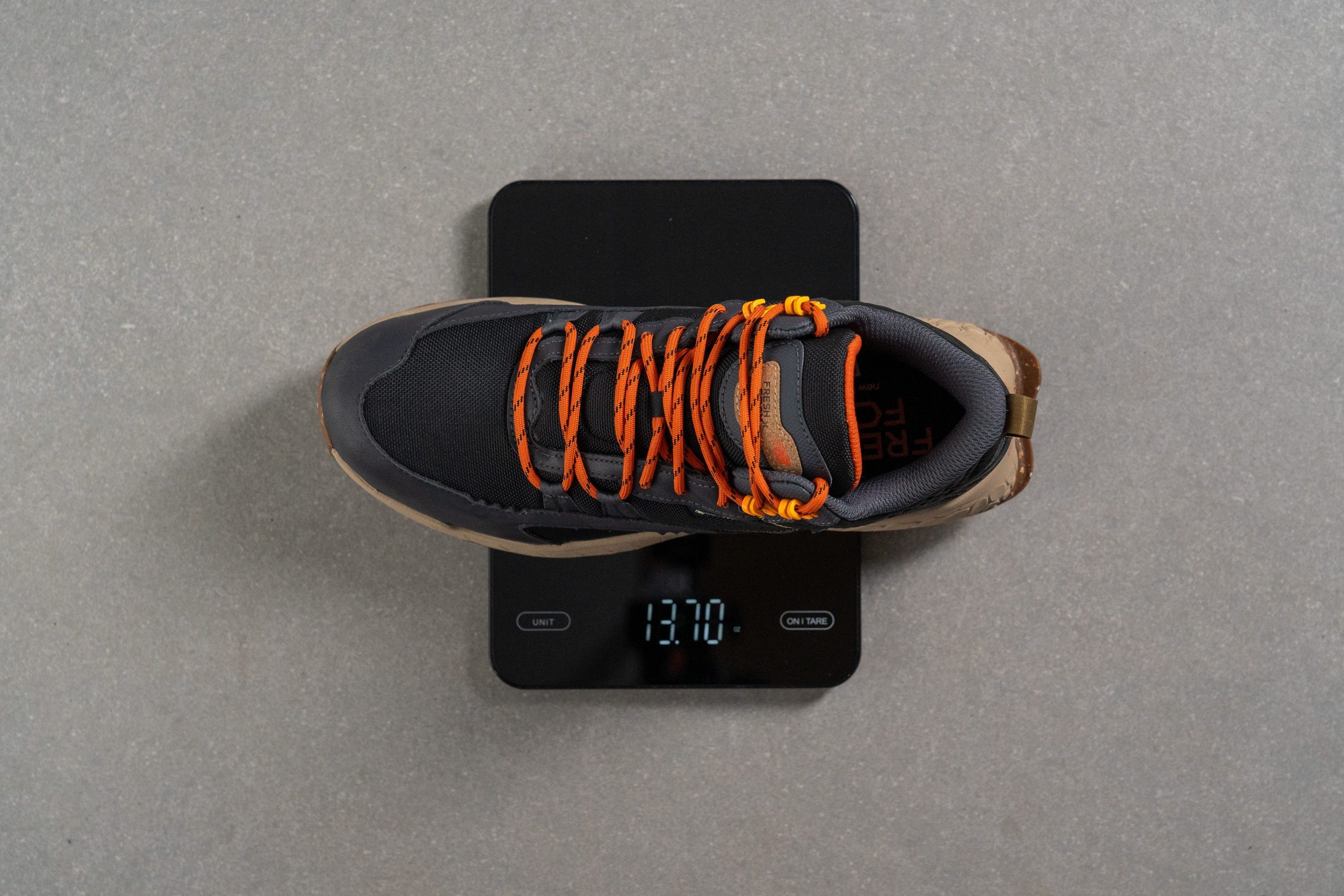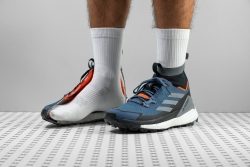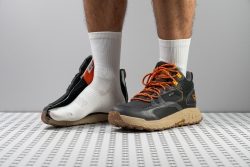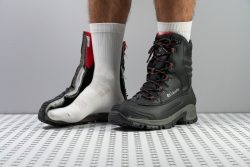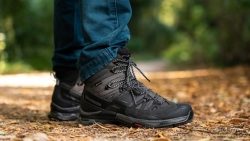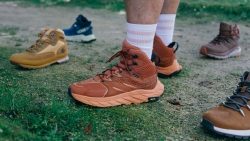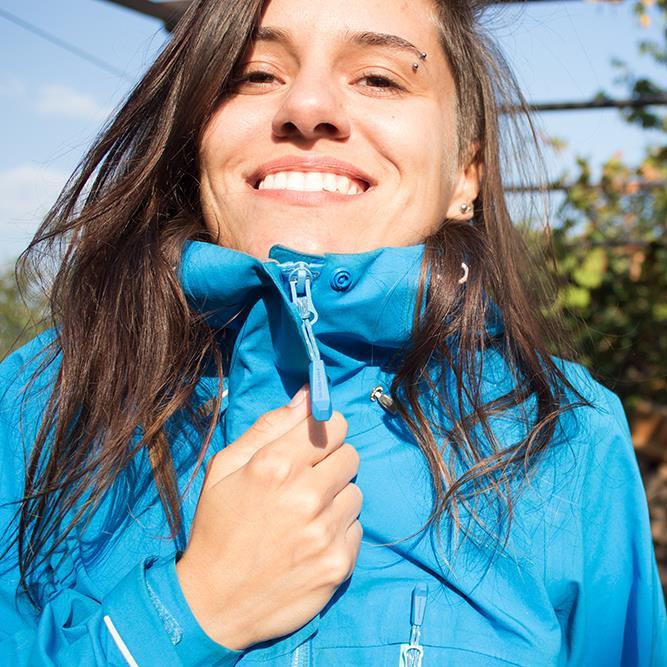5 Hiking Boots With The Best Shock Absorption in 2025

We buy shoes ourselves. We earn commissions when you buy through us, at no extra cost. Why trust us
Shock absorption tells us how protective the midsole is. It’s a very valuable ability of the midsole to dampen the impact forces and, the better it is at that job, the less stress is sent toward hikers’ legs. In this guide, we cover what high shock absorption actually means, how to find hiking boots that offer it, and who high shock absorption is actually good for.
How we test Hiking boots with the shock absorption
Our lab is completely independent, which means that we buy all the boots with our own money and we have no deals with the brands. Not even brand ambassadors on the team. All the boots are submitted to the same tests in the lab, under the same conditions. The tests are standardised and we explain them all in great detail on our Methodology page.
When testing the shock absorption (and energy return) of hiking boots, we follow the ASTM F1976 methodology. As you can see in the video below, we use a specialised machine for this and we also detach the upper from the platform so that the machine can have free access to the heel area.
The test is performed by dropping an 8.5 kg mass from a 50 mm height, with a total energy input of 5J. The first 25 repetitions simulate natural break-in, while the last 5 are used for our lab data (we calculate the average).
Based on our personal experience with the hiking boots during the test hikes and the lab data, we select the best from the best in various categories.
Best hiking boots with high shock absorption overall















































What makes it the best?
Adidas combines plush comfort and agile speed in the Terrex Free Hiker 2. This boot is light, energetic, and adaptable, making it easy to manoeuvre through mixed terrains. Underfoot, it ensures zero muscle strain with its top-notch protection and generous cushioning. Backed up by lab results, it’s our best high shock absorption hiking boot.
We felt like we could trek for countless hours in this well-cushioned pair. Testing for its shock absorption, its strong 121 SA score impressed us, making it a mind-boggling 30.1% more protective than the average hiking boot. Its above-average 38.4/24.0 mm stack also reduces the harshness of the ground.
With every plush landing, a bouncy release follows. The midsole feels pleasantly lively, proven by a solid 66.0% rating in our energy return test. Speeding up is easy with this dynamic boot underfoot!
Amazingly, Terrex Free Hiker 2 maintains a light 15.0 oz (425g) figure despite its well-cushioned sensation. It’s one less burden to carry in the mountains since it’s 20.0% lighter than average. We also found the pliable midsole easy to control. Our flex test validates it’s 49.2% more bendable than average, making it extremely comfortable for long hours of wear.
Note that this boot requires a break-in period before unlocking its full comfort. Best to take it on quick walks before taking it out to a full-on hike.
Pros
- Extremely well-cushioned
- Exceptionally lively and bouncy underfoot
- Luxuriously padded interior
- Grippy and durable lugs
- Tackles wet surfaces confidently
- Very flexible and forgiving
- Excellent airflow
- Feels incredibly stable underfoot
- Supportive heel collar
- Rockered midsole
- Relatively lightweight
- High-quality construction
- Eye-catching design
Cons
- Needs breaking in
- Tricky to put on
- Expensive
High shock absorption hiking boots with the best comfort

















































What makes it the best?
While the high shock absorption hiking boots we tested all feel well-cushioned, the HOKA Kaha 3 GTX ultimately leads the pack in terms of comfort. Besides its solid impact protection, lab tests show it features a mega-stack that reduces ground feel. Plus, we can mindlessly and confidently trek through trails since the grippy Vibram Megagrip rubber and the highly stable base take care of us.
Our journey on foot is pure bliss with the Kaha 3 GTX serving cloudlike landings. We tested for its shock absorption and confirmed a well-cushioned 120 SA rating. At this rate, it reduces the forces of landing by 29.0% better than average. Its ultra-thick 41.9/30.4 mm stack also serves as a layer of protection under our feet. Featuring a steep 11.5 mm drop, it reduces strain on our lower leg muscles.
Because this boot features the highly reliable Vibram Megagrip rubber, we can tackle mixed surfaces and rainy weather fearlessly. Our traction test verifies that it’s very grippy with its 0.65 friction score. Plus, its 3.2 mm lugs feel versatile and effective on various surfaces.
Kaha 3 GTX feels solid and supportive with its wide and rigid base. It’s highly resistant to ankle twists (5/5), and its broad 115.0/96.4 mm base makes it difficult to lose our footing.
Unfortunately, its massive build tipped the scales to 19.4 oz (550g). Its heavy weight will feel like a burden on short and easy hikes.
Pros
- One of the best cushioned boots ever
- Extremely comfortable for long miles
- Highly stable and supportive
- Excellent traction on smooth surfaces
- Grips mixed and hilly terrain well
- Contains sustainable materials
- More streamlined than the Kaha 2
Cons
- Lugs got much shallower
- Heavier than average
Best versatile hiking boots with high shock absorption
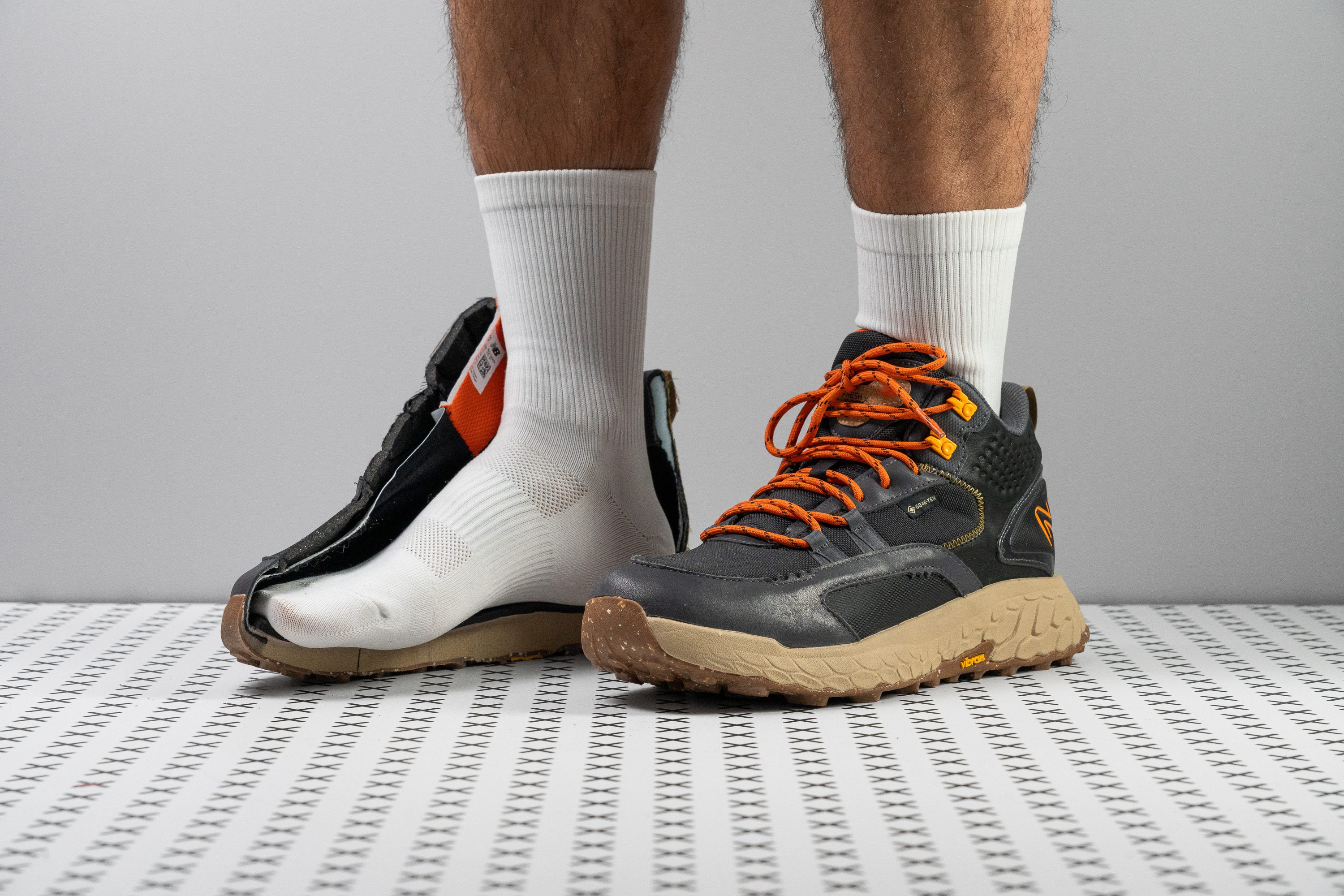









































What makes it the best?
Whether on our walks around the city or on our treks in the mountains, the New Balance Fresh Foam X Hierro Mid GTX made our feet feel at home. Comfort is prioritised with the Fresh Foam X delivering premium impact protection, while its light and flexible build and Vibram Megagrip outsole allow us to be agile on mixed terrains. Among the high shock absorption hiking boots we assessed in the lab, Hierro Mid GTX is our most versatile pick.
This boot feels immensely light, almost as if it’s a trail shoe. Our scales confirm it’s only 13.7 oz (388g), making it 26.9% below the average hiking boot. Because of its weightless sensation, it feels comfortable for all-day wear. It’s also easy to control since it’s 29.8% more flexible than average.
The Fresh Foam X cushioning generates tonnes of impact protection, which reduces the load on our muscles and joints. In our shock absorption test, it excels with a solid 115 SA rating, softening each landing effectively.
Underfoot, we assessed exceptional grip on various surfaces, courtesy of the reliable Vibram Megagrip outsole. It’s lined with 4.1 mm lugs, which have micro dots in their design for added traction.
While the boot is waterproof, we recommend avoiding above-ankle waters since the tongue is only semi-gusseted and has a risk of overflow.
Pros
- One of the softest hiking boots
- Generous cushioning for long miles
- Much lighter than average boot
- Lively and bouncy ride
- Excellent stability and lockdown
- Flexible forefoot
- Effective waterproofing
- Durable upper and outsole
- Grippy on varied terrain
Cons
- Gets notably firmer in low temps
- Low flood level
- Not for technical terrain
Best high shock absorption hiking boots for harsh winter
































What makes it the best?
The Columbia Bugaboot III features plush padding and outstanding warmth in its interiors, making it a cosy place to be in during sub-zero temperatures. Lab results show it has no ventilation, remarkable joint protection, and deep, reliable lugs, making it our best high shock absorption hiking boot for harsh winter conditions.
We sliced the boot to dive deeper in the lab and found its impermeable leather upper and 200-gramme insulation offer top-notch insulation. The boot has no holes for cold air to access, with its thick 14.2 mm tongue padding preserving our body heat within the boot. True enough, it received the lowest 1/5 breathability rating in our smoke test.
Bugaboot III effectively soaks up impact and softens each landing. It scored a high 114 SA in our shock absorption test, making it 22.6% more cushioned than average. Additionally, its massive 46.9/30.7 mm stack serves as a thick buffer between our feet and the cold ground.
We measured the lugs at 5.7 mm, making it 1.4 mm deeper than average. It clings to soft snow or icy surfaces well, allowing us to trek with confidence on slippery pavements.
However, with all its layers, it weighs a heavy 26.0 oz (737g), making it significantly 38.8% bulkier than average. We recommend only using this boot in extremely cold conditions.
Pros
- Jaw-dropping comfort
- Remarkable insulation
- Watertight upper
- Excellent durability
- Plenty of cushioning
- High level of support
- Reliable grip
- Affordable for its kind
Cons
- Restrictive toebox
- Heavier than average
Best waterproof hiking boots with high shock absorption
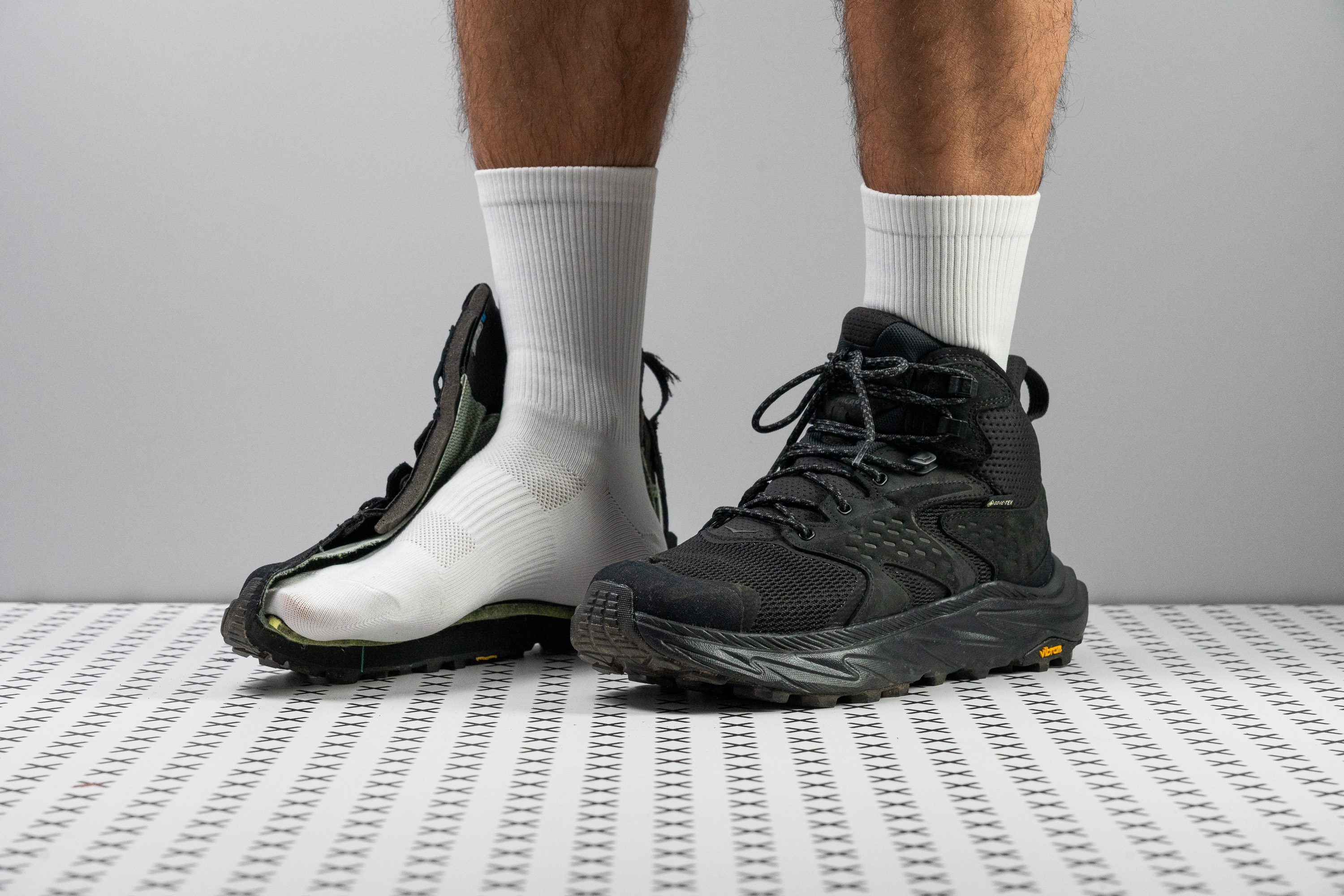












































What makes it the best?
With its protective combination of cushioning, impermeability, and traction, the Hoka Anacapa 2 Mid GTX is made for wet conditions. Featuring aggressive lugs, the Vibram rubber, and Gore-Tex membrane, it’s our best waterproof pick among high shock absorption hiking boots we assessed outdoors and in the lab.
We tested the boot in our smoke test, and not a single wisp of air could escape. The Gore-Tex membrane and upper fabric effectively block ventilation, earning the lowest 1/5 breathability score. This is good news for waterproofing, because it resists water from entering the shoe. Testing the boot in puddles and streams, we can attest to its waterproofing capabilities.
The midsole offers a well-cushioned ride, evidenced by its high 118 SA shock absorption score. Its SwallowTail design enhances comfort by leading us from heel to toe effortlessly. Meanwhile, its minimal 17.4 oz (494g) build makes the boot easy to manoeuvre and wear all day.
This boot handles water effectively from top to bottom. With the Vibram rubber and deep 5.0 mm lugs underneath, the outsole offers exceptional gripping power. We traversed through slippery surfaces and wet rocks with confidence and ease, proving the shoe’s reliable traction.
Unfortunately, the extended heel gets in the way sometimes when dealing with rock-heavy paths and descents. This feature shines best on hard-packed surfaces.
Pros
- Well-cushioned for long miles
- Very comfortable step-in feel
- Highly stable platform
- Excellent waterproofing
- Solid grip, even on soft terrain
- More flexible than other boots
- Decent durability for moderate hikes
- A lot of sustainable components
Cons
- Extended heel catches rocks
- Not for technical terrain
- Gained 2 ounces
High shock absorption is, based on our data, shock absorption higher than 100 SA. These hiking boots are recommended for:
- Heavy hikers
- Hikers who mostly stick to light-to-moderate trails
- Hikers who frequently undertake longer hikes while carrying heavier loads.
When you want to go fast and light, on the other hand, you may look for something agile and closer to the ground. Technical terrain also requires stiff, stable, protective footwear, and shock absorption is often low in such boots.
The importance of good shock absorption
Shock absorption or shock attenuation is not just about what happens each time you land on the ground. It is, of course, incredibly important for a hiking boot to be able to dampen the impact forces, but what many hikers forget is what happens when covering long distances. These forces accumulate and, in hiking boots with low shock absorption, premature fatigue is inevitable.
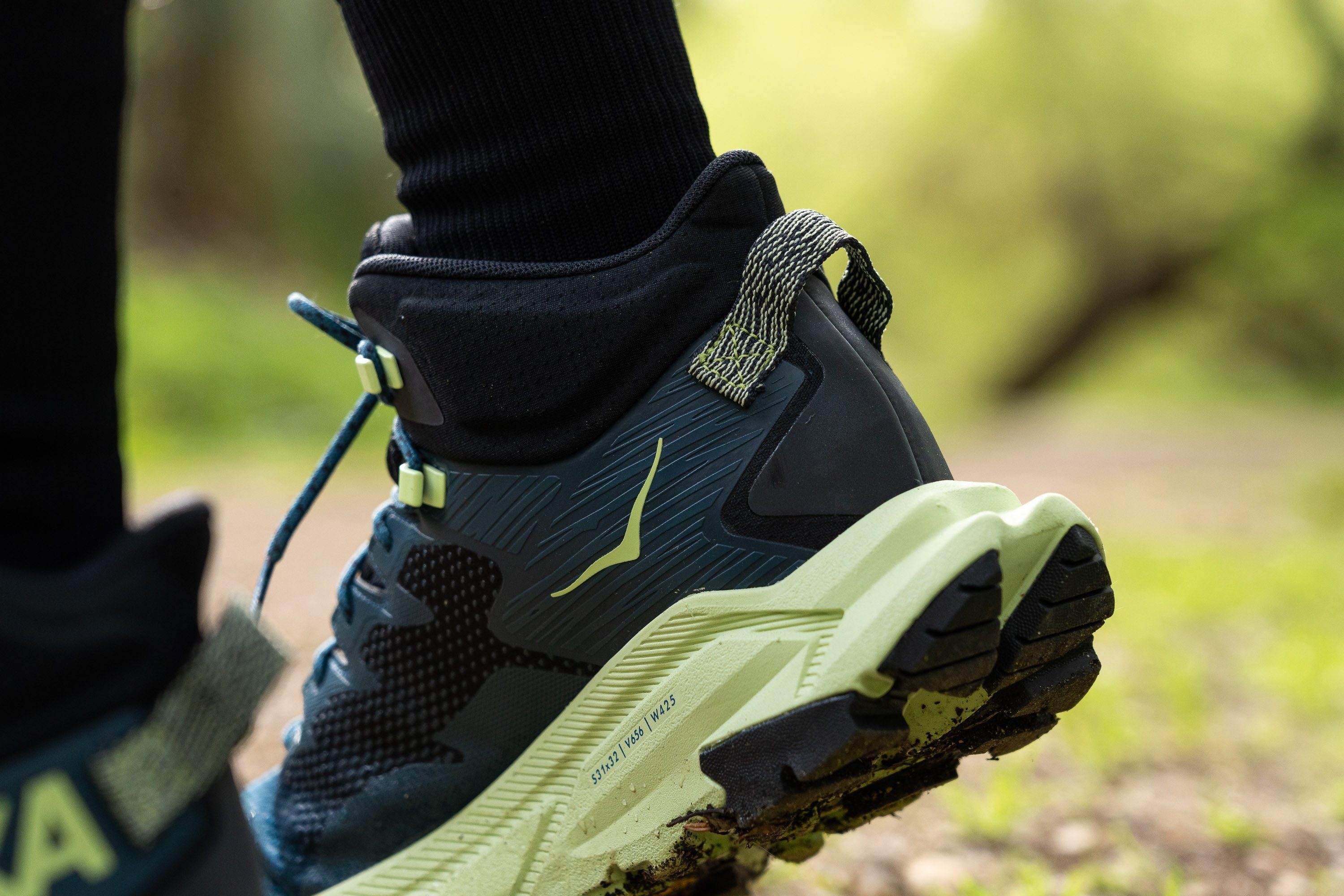
Good shock absorption helps your legs stay fresh for longer and it reduces the overall toll on the body.
5 features of hiking boots with high shock absorption
What can you expect from hiking boots with high shock absorption?
- You can’t say whether a boot has high or low shock absorption by looking at it. The best advice is: check the lab test results. We consider shock absorption high when it’s higher than 100 SA.
- These hiking boots feel great on light and moderate trails, especially for heavy hikers.
- High shock absorption does not mean heavier boots. In fact, these boots are lighter than average!
- High shock absorption is rarely found in technical boots. The more aggressive the terrain gets, the less shock absorption is prioritised because the spotlight goes to the foot protection, platform stiffness, and stability.
- These boots are actually cheaper (on average). More expensive technologies (waterproof membranes, strong protective materials, rock protection, and so on) are found and combined in hiking boots for technical terrain.
How is shock absorption related to midsole softness?
Many hikers correlate softness with comfort. And while it makes sense, there’s the other part of this story, and that’s shock absorption. The initial feel of the boot is perceived thanks to that softness. The midsole's ability to dampen impact is not something that can always be felt on the first try.
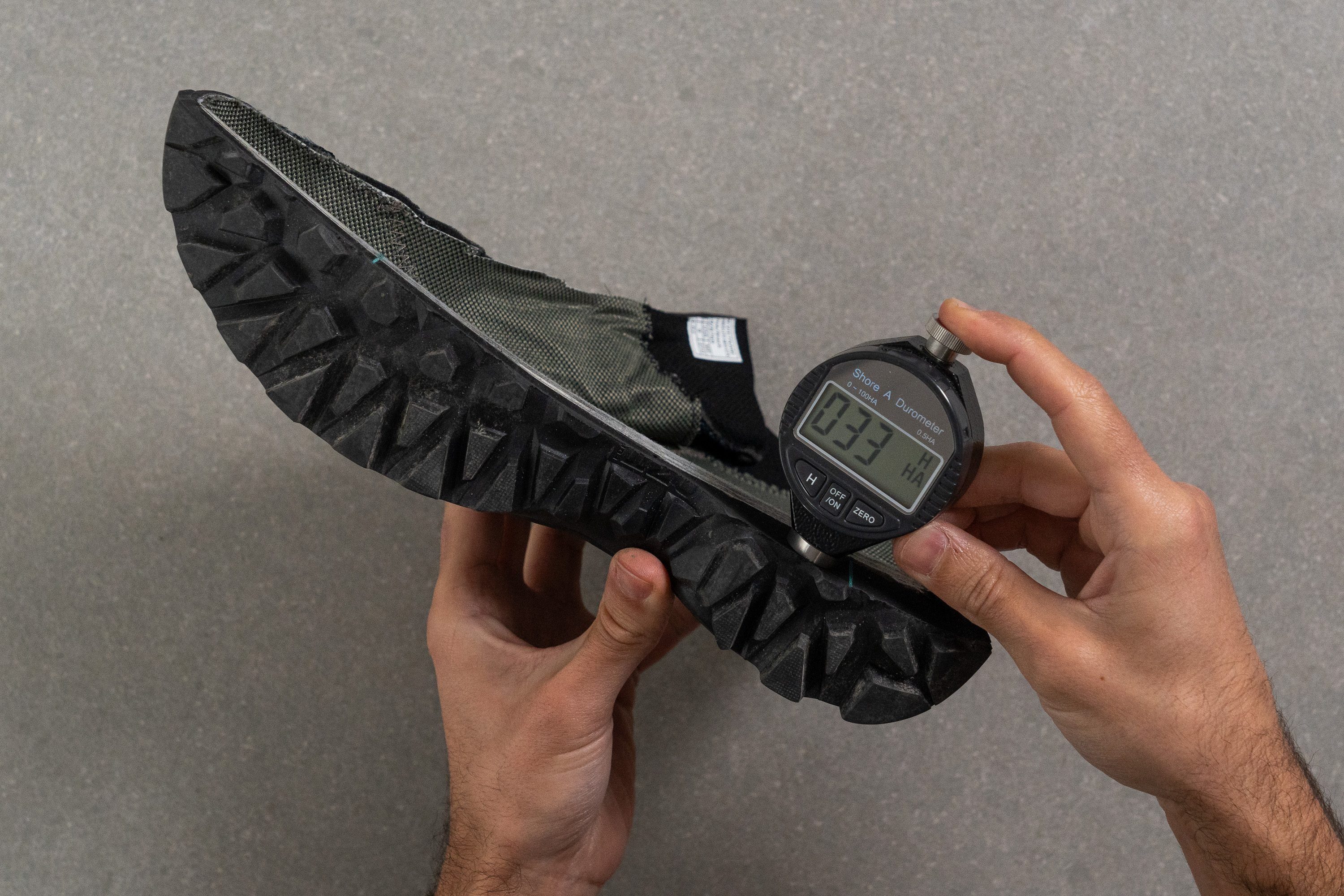
In our lab, we also measure the softness of the midsole. We use a shore A durometer and we stick its needle into the midsole. We always do this on the boot cut in half, so that the durometer’s needle can access the raw side of the midsole (foam), which is not covered with some protective overlays that give the wrong results (the outer layer of the midsole).
As always, we’ll dig into numbers.
|
Hiking boots with… |
Average midsole softness (HA) |
|
Low shock abs |
36.8 |
|
Medium shock abs |
26.6 |
|
High shock abs |
21.8 |
Based on what we see, it’s clear that hiking boots with good shock absorption are also softer on average. It also makes sense that the boots with low shock absorption are firmer, given that they are mostly made for demanding terrain where firmness and stiffness help immensely with stability.
Why low shock absorption is great as well
Because it simply depends on the purpose of your hiking boots! What do you need them for: light, moderate, or demanding (technical) terrain? Lower shock absorption is, on average, found in boots for technical terrain, so it’s not about saying it’s bad, but saying it’s good for that purpose. For moderate and technical hikes, brands focus on other features that matter more (protection from harsh terrain and obstacles, increased stiffness and stability, quicker ground-contact time, etc.).

Here’s how we group hiking boots based on their shock absorption test results: low shock absorption means the boots scored <85 SA, medium shock absorption applies to the boots that scored in the 85-100 SA, and anything higher than 100 SA is considered high shock absorption.
Shock absorption vs. stack height in hiking boots
This one should be intuitive and if you go by that route you may be very wrong! Simply, the higher the stack height, the better the chances of having enough midsole to cushion the impact. Therefore, one could expect higher stack heights in hiking boots that offer high shock absorption. Let’s look at the data and how that person would be wrong.
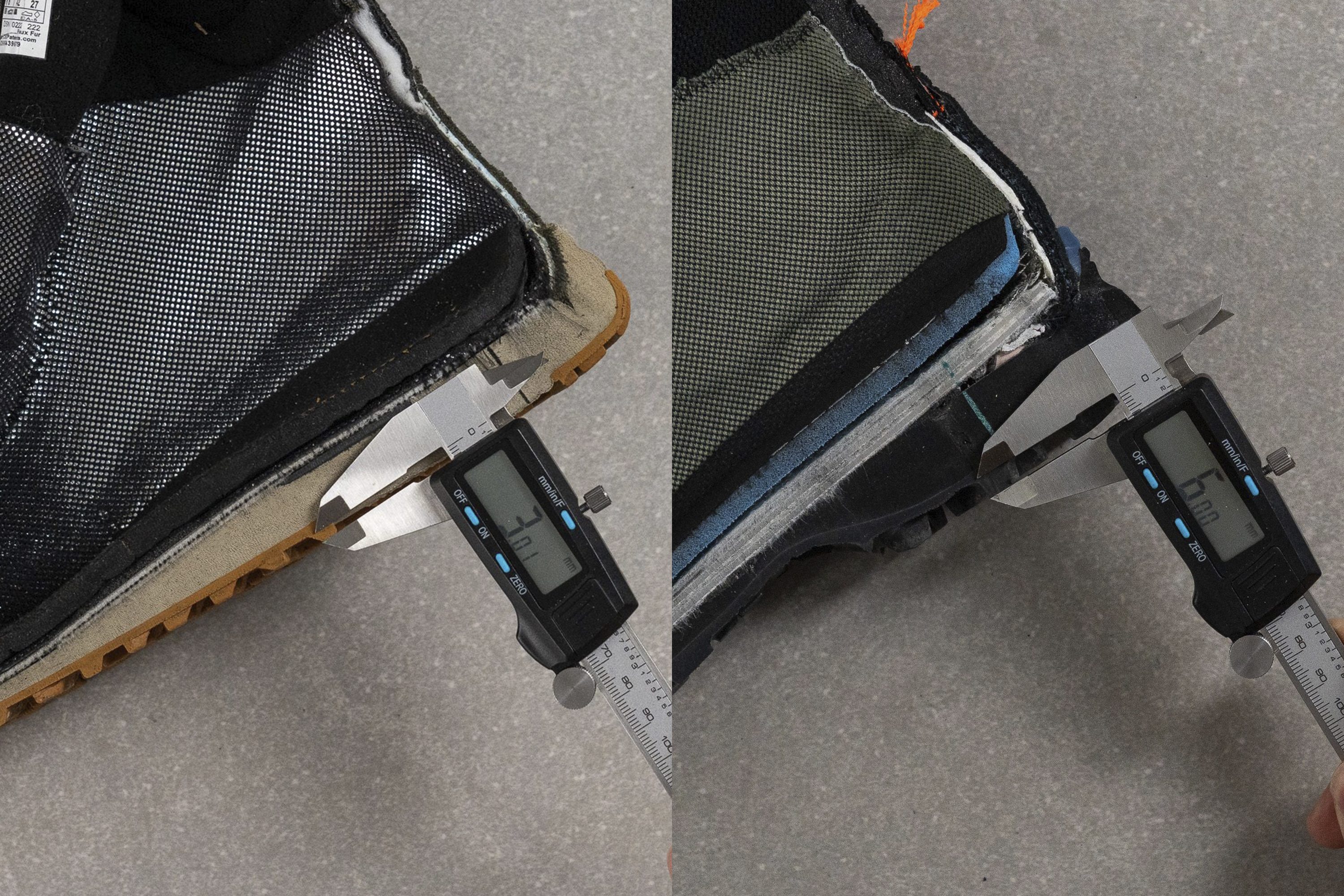
Average heel stack heights for hiking boots in low, medium, and high shock absorption groups are 37.4 mm, 34.4 mm, and 37.3 mm, respectively.
Unlike in running shoes, the priorities here lie elsewhere: thick outsoles (for protection), deep lugs (for traction), and stiffness of the platform (when stability is needed). Additionally, the thickness of the lugs and outsole plays a significant role, as they contribute to the overall stack height. The thicker they are, the thinner the foam that would dampen the impact.
Energy return of hiking boots with high shock absorption
Now that we know what good shock absorption is about, it’s also important to highlight that there are midsoles that are soft and protective but dull at the same time. These midsoles can be quite tiring (muscle fatigue) because our feet have to work extra to keep pushing forward. That’s where our energy return test enters the scene.
Energy return tells us how responsive (lively) the ride is. The higher it is, the better, especially if you’re going fast. For average paces, it’s expected to have boots with average energy return, given that, in hiking boots, other features like traction, protection from sharp elements or harsh weather, stability, and arch support are higher on the priority list.
Why hiking boots with high shock absorption cost LESS
It’s not like retailers think “we have to charge more for shock absorption”. It’s all about the technologies.
|
Hiking boots with… |
Average price |
|
Low shock absorption |
£240 |
|
Medium shock absorption |
£180 |
|
High shock absorption |
£190 |
This table is a perfect example of looking at one piece of the puzzle only. No, we can’t say that with shock absorption, the prices go higher as well. Here’s another chart that can shed some light on this riddle.
|
Trail terrain |
Average shock absorption |
|
Light |
101 SA |
|
Moderate |
97 SA |
|
Technical |
81 SA |
From this, we can clearly see that hiking boots for light and moderate hikes have the highest shock absorption. These hiking boots are the cheapest on average. Other hiking boots, made for moderate and especially for technical terrain, are more expensive because they have to offer much more protection (in the form of harsh materials, toe bumpers, deep lugs), they are often waterproof, and the platforms are stiffer.
What’s also important for this terrain is for the boots to be more stable and closer to the ground so that the feet can quickly adapt to the varying terrain. This is why shock absorption is less important for this type of hiking and matters the most for daily hikers.
How heavy are hiking boots with high shock absorption?
The average weight of hiking boots with low shock absorption is 612.9g or 21.6 oz, with moderate shock absorption, it’s 465.8g or 16.4 oz, and the average weight of hiking boots with high shock absorption sits at 492.1g or 17.4 oz. The heaviness of boots with low shock absorption completely makes sense given that those boots are mostly made for technical terrain where heavy features and technologies are a must.
Given that the average weight of all hiking boots we’ve tested so far sits at 531g or 18.7 oz, we can say that hiking boots with high shock absorption are lighter than the average.
